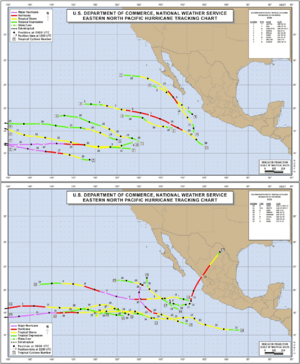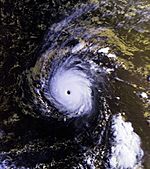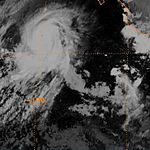1994 Pacific hurricane season facts for kids
 |
|
| Season summary map | |
| First storm formed | June 18, 1994 |
|---|---|
| Last storm dissipated | October 26, 1994 |
| Strongest storm | Gilma-920 mbar – |
| 20 | |
| Total fatalities | 4-8 |
| Total damage | $20 million (1994 USD) |
| seasons 1992, 1993, 1994, 1995, 1996 |
|
The 1994 Pacific hurricane season was a time when many powerful storms formed in the Pacific Ocean. It officially began on May 15, 1994, in the eastern Pacific and on June 1, 1994, in the central Pacific. The season ended on November 30, 1994. These dates are when most tropical cyclones (like hurricanes) usually form in this part of the world.
This season was special because it had an unusual number of very strong storms. Hurricanes Emilia, Gilma, John, and Olivia were all incredibly powerful. Also, Hurricane Rosa caused some serious problems in Mexico.
Contents
Storm Activity in 1994
The 1994 hurricane season had a bit more storm activity than usual. Five hurricanes grew to be very strong, reaching Category 2 or higher on the Saffir-Simpson Hurricane Scale. This scale helps us measure how strong a hurricane is. Besides these, there were four other hurricanes and eight tropical storms. In the middle part of the Pacific, two tropical storms and one hurricane also formed.
Hurricane Emilia: A Powerful Storm
Hurricane Emilia was a super strong storm, reaching Category 5! This is the highest category for hurricanes. It looked like it might hit the Hawaiian Islands when it was at its strongest. But then, it ran into strong winds that made it weaker. Even so, it caused some small damage to roofs and knocked down a few trees. It also brought a lot of rain.
Hurricane Gilma: The Strongest of the Season
Hurricane Gilma was the most powerful storm of the 1994 season. It was the first Category 5 storm in the East Pacific since Hurricane Ava in 1973. It's also the strongest storm ever recorded in the East Pacific during July. Overall, it's one of the top five strongest storms in that area.
Hurricane/Typhoon John: The Longest Lasting Storm
| John satellite image and storm path | |
|---|---|
Hurricane John holds a record! It was the longest-lasting tropical cyclone ever recorded on Earth. It started forming on August 11 near Mexico. Thirty-one days later, it finally broke apart near Alaska. During its long journey, John became a Category 5 hurricane. It even crossed the International Date Line twice! John caused about $15 million in damage on Johnston Atoll.
Tropical Depression One-C: Heavy Rains in Hawaii
On August 9, a tropical depression formed about 740 miles (1190 km) southeast of Hilo, Hawaii. A tropical depression is a weak storm that can grow stronger. This one moved west but didn't get stronger and disappeared a few days later. However, it brought a huge amount of rain to the island of Hawaii, over 15 inches in some places!
This heavy rain caused major flooding in Hilo. It was the worst flooding there in 40 years. The floods destroyed two homes and damaged 214 others, with 14 being badly damaged. Roads and businesses were also hurt. The total damage on the island was about $5 million. Flooding also happened in Maui, where landslides blocked parts of a highway.
Hurricane Olivia: Another Super Strong Storm
| Olivia satellite image and track map | |
|---|---|
Hurricane Olivia was the second strongest storm of the 1994 season. It's considered one of the ten most powerful East Pacific hurricanes ever recorded. When it happened, it was the strongest storm ever seen in October.
Hurricane Rosa: Landfall in Mexico
Hurricane Rosa started as a tropical depression on October 8. It took a while to get organized, but by October 11, it became a tropical storm and was named Rosa. The storm moved very slowly at first. Then, it turned north and northeast. Rosa quickly became stronger, reaching Category 2 just before it hit land near La Concepcion, Mexico, on the morning of October 14.
Rosa quickly weakened as it moved over the mountains of Mexico. However, its clouds moved north, bringing moisture to Texas. This moisture helped cause a big flood event in east Texas a few days later.
Sadly, four people died because of Rosa, two in Nayarit and two in Durango. Four people were also reported missing in Sinaloa. More than 100,000 homes were damaged in Nayarit. Telephone poles and power lines were knocked down in Sinaloa. The heavy rain also caused landslides and flash-flooding in the mountains.
See also
 In Spanish: Temporada de huracanes en el Pacífico de 1994 para niños
In Spanish: Temporada de huracanes en el Pacífico de 1994 para niños





